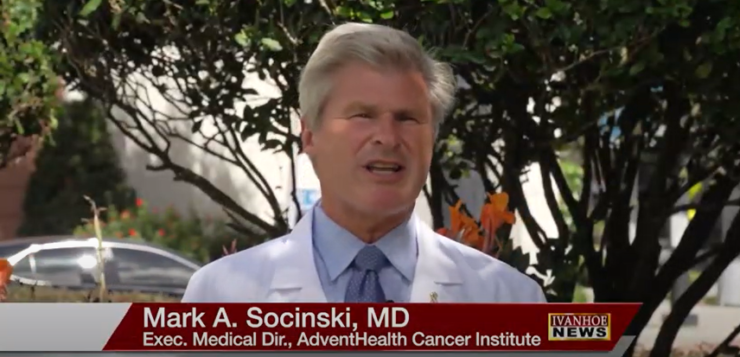Mark A. Socinski, MD, Executive Medical Director, AdventHealth Cancer, talks about how doctors are using a patient’s genes to increase their survival rate for advanced lung cancer.
What are you and your colleagues looking at with your research?
SOCINSKI: Lung cancer has become one of the premier cancers for targeted therapies. The reason is because lung cancer is made up of several different molecular subsets of the disease. Twenty years ago, lung cancer was a one size fits all disease, and now it’s a very heterogeneous population of patients based on various DNA alterations. Our specific research has focused on a number of these, but most recently the MET exon 14 skip mutation. This occurs in approximately three to four percent of non-small-cell lung cancer cases and is what we call an oncogenic driver, meaning that it causes the cancer to grow. So, in knowing this, there are specific targeted therapies that can inhibit the growth of the cancer. In the past year, we’ve had two oral targeted therapies approved by the FDA specifically for patients with MET exon 14 skip mutations that are much more effective than chemotherapy and immunotherapy in these patients. It’s very important that comprehensive genomic testing is part of the initial evaluation of advanced-stage patients to identify not only the MET Exon 14 skip mutation but several other DNA alterations in which oral targeted therapies are approved.
How would you find out that somebody has this mutation?
SOCINSKI: There is no way to predict this mutation based on the phenotype of patient. You can’t pick them out of the crowd. Cancer is a disease of your DNA. You must interrogate the DNA. As I mentioned, comprehensive genomic testing is part of the standard of care. The testing platforms should specifically test for MET exon 14. So, it really is a diagnosis made in molecular pathology and must be done on every patient to be sure they don’t have this alteration.
Is it possible to find out if someone has that mutation before they even get cancer?
SOCINSKI: No. This is a mutation that causes the cancer. It’s not part of our normal DNA. This is a specific genomic alteration that occurs in cancer. We don’t know why it occurs, only that it does occur. So, this is not something that can predicted or be used in screening or anything like that.
If they have this mutation, it makes the cancer grow faster. Is there any other characteristics of the mutation that happens within the cancer?
SOCINSKI: It occurs in about three to four percent of all the non-small-cell lung cancer cases. There is really no way to identify it by clinical features, or pathologic features, or radiological features. It gets back to doing the testing that needs to be done to find these patients. That’s really the only way.
You were mentioning other mutations as well. What are the implications for those?
SOCINSKI: Going back to 2004, EGFR mutations were discovered and now we have highly effective therapies for these patients. Subsequently, ALK and ROS1 fusions were described, and we also have targeted therapies for these patients. We even have a new therapy for a certain subset of KRAS mutations which are the most common mutations we see. We’ve known about KRAS mutations since the 1980’s, but never had a true targeted therapy until recently. This new targeted therapy is only for a subset of the KRAS patients.
How recently has the MET Exon 14 mutation information been around?
SOCINSKI: The MET exon 14 skip mutations were initially described in lung cancer probably about four to six years ago. The drugs used in this case tend to be rapidly developed in this setting because what you’re looking for in the FDA approval of these drugs is that you have an overall response rate and some durability of that response. A lot of these drugs are approved on the accelerated approval path for the FDA. Of course, an accelerated approval requires confirmation of benefit in subsequent trials. But at least we’re getting these drugs to the patients and they’re highly effective.
Since the drugs are a targeted therapy for the mutation, does that help with the speeding up of the approval process?
SOCINSKI: Yes. If you identify a molecular alteration that you believe is driving the cancer. We like to use the term oncogenic driver, meaning this is the thrust or the engine that’s driving the patient’s cancer. If you identify that, we call that a target. Many of these targets are relatively targetable with what we call targeted therapies. So, you have a specific target, you have a targeted therapy, you can identify the patients who have the target. That process of coupling a target with a targeted therapy makes it much more effective and much more rapidly approved by the FDA. However, each accelerated approval does need to have confirmatory studies done following FDA approval to be sure that we fully understand the benefit.
With your research, what do you believe that can do for someone who either has non-small-cell lung cancer or just got diagnosed?
SOCINSKI: I always say to my patients with non-small-cell lung cancer that I have several buckets of treatment available as their oncologist, and my job is to figure out which bucket I need to put them in. The FDA has nine biomarker approved categories of treatment. So, each of those nine tests need to be done in every patient because if you find that target, you’re in the targeted therapy bucket and I’m going to give you targeted therapy. If you don’t have any of the targets, then you go into different buckets such as immunotherapy, immunotherapy plus chemotherapy, or chemotherapy alone. So again, if you look at lung cancer 20 years ago, it was kind of a one size fits all. If you look at lung cancer in 2021, it’s a very heterogeneous disease. There’s lots of demands on genomic testing to identify which bucket of treatment are you going to put these patients in. As their physician, we want to get the right treatment to the right patient at the right time.
You mentioned the oral therapies that are new. How does that work?
SOCINSKI: Many of these targeted therapies are oral therapies. They’re given by mouth and do have a side effect profile. It tends to be very different than what people think of with chemotherapy, but they do have a side effect profile. In general, the oral therapies are better tolerated than the intravenous chemotherapy that patients traditionally think of when they think of cancer chemotherapy. The convenience of taking an oral tablet once or twice a day, depending on what the drug is, is much more attractive than having to go to an infusion center and have an IV or have an indwelling catheter where you have to get your chemotherapy treatment through. The strategy with these things is that we continue them as long as they’re working. I personally have had patients that have been on targeted therapies for years with control of their cancer. Now, that doesn’t happen in everybody, but there are significant numbers of patients that can take oral therapies for their cancer. It’s very gratifying. It’s convenient. It’s less toxic. Patients don’t have the troublesome nature of going back and forth and getting IV infusions and all these sorts of things. So, there are some clear advantages to oral therapies.
What are the two drugs that were approved for the MET Exon 14?
SOCINSKI: One is called Capmatinib and the second drug is called Tepotinib.
Interview conducted by Ivanhoe Broadcast News.
END OF INTERVIEW
This information is intended for additional research purposes only. It is not to be used as a prescription or advice from Ivanhoe Broadcast News, Inc. or any medical professional interviewed. Ivanhoe Broadcast News, Inc. assumes no responsibility for the depth or accuracy of physician statements. Procedures or medicines apply to different people and medical factors; always consult your physician on medical matters.
If you would like more information, please contact:
Kristi Powers
kristi.powers@adventhealth.com
Sign up for a free weekly e-mail on Medical Breakthroughs called First to Know by clicking here




